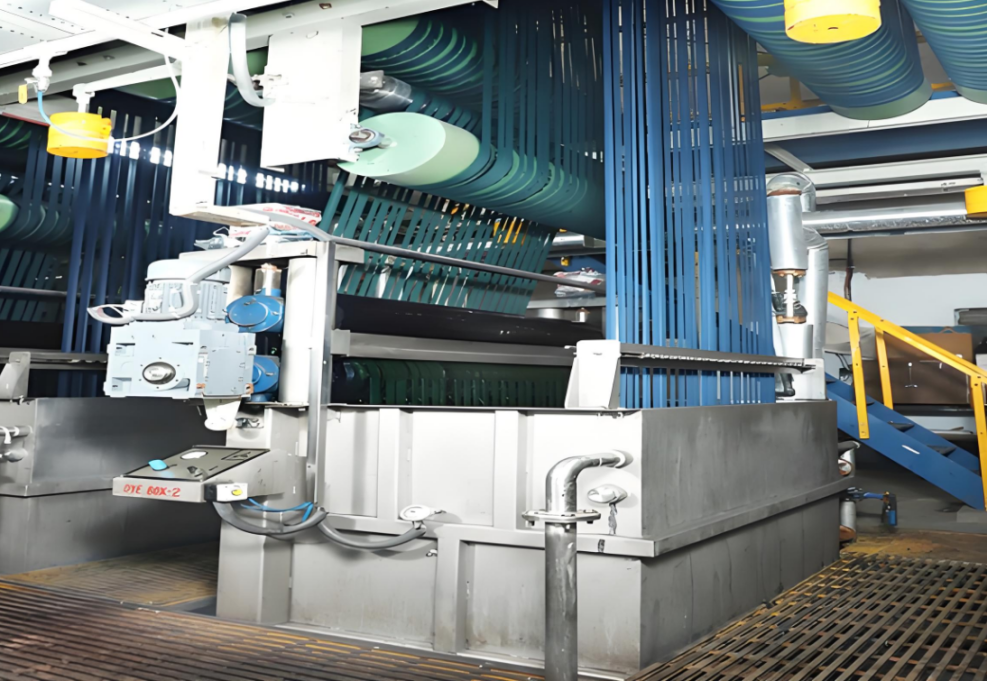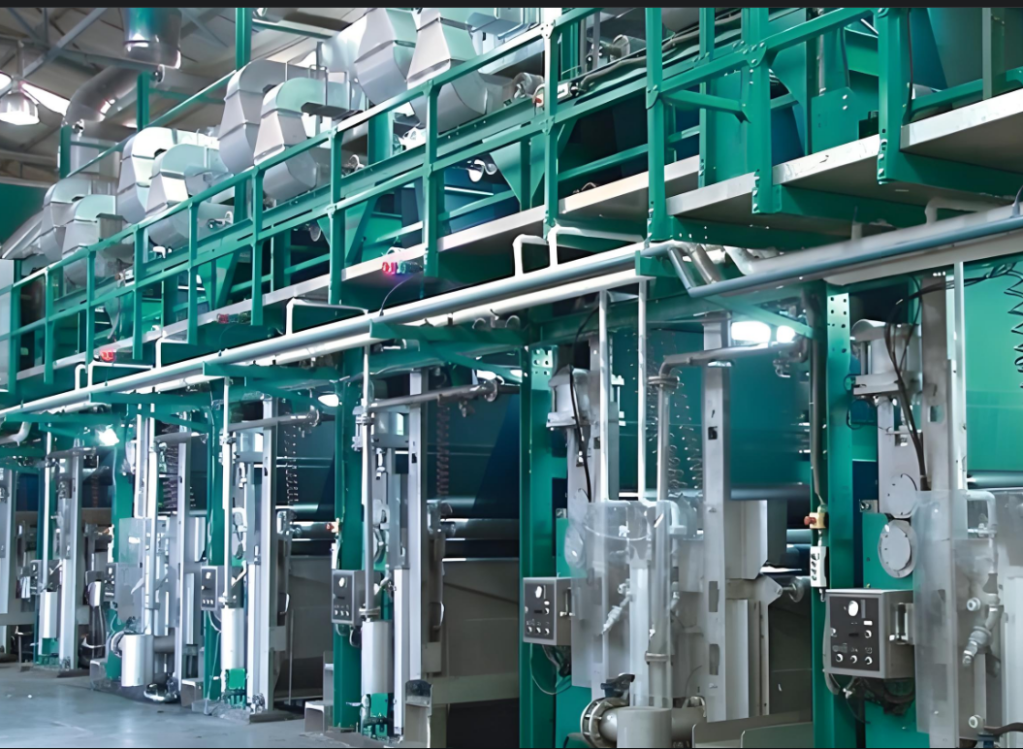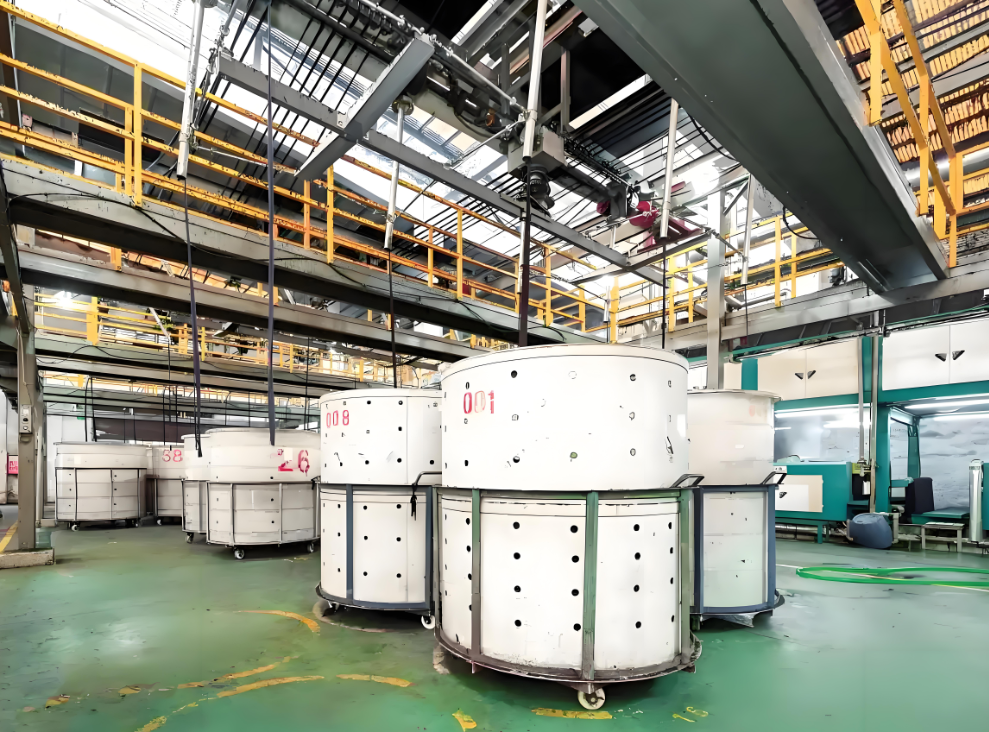Denim dyeing primarily involves dyeing the warp yarns. Initially, ancient natural indigo dye was used for this process. However, due to limitations in natural resources, synthetic indigo dye is now used. Indigo dye is a type of vat dye, which is inherently insoluble in water. Under alkaline conditions, it is reduced using a reducing agent to form a water-soluble leuco form that has an affinity for the fibers. After the fibers are dyed, the leuco form undergoes oxidation, converting it into an insoluble form that firmly adheres within the fibers, completing the dyeing process.
1.Dyeing Methods
1.1 Rope dyeing process:
Rope dyeing uses a ball warping machine to pull creel yarns, which are then run through a lease stand with a specific comb and lease rods to ensure accurate end registration. These pulled ends are then merged into a bundle and sent through a condenser tube assembly, which is then passed to make a rope with 350-400 ends. After that, the ropes are wound on drums. The beam is unloaded and put on a dye range creel once it has been fully coiled. Ropes are dyed by passing them through a pre-treatment bath, then multiple dipping in various indigo baths, with intermediate squeezing and skying.
1.1.1 Advantages of Rope Dyeing
l No cross-shade variation
l Low thread wastage
l High productivity and flexibility in production
l Less reduction agent use
l No time waste during lot changes
l Versatility in denim production
1.1.2 Disadvantages of Rope Dyeing
l There is a lot of space required
l Immersion and oxidation times are considerably longer
l An additional step of opening ropes after dyeing is required
l There is less color flexibility
l The production cost is high

1.2 Slasher dyeing:
Slasher dyeing involves pre-treatment of denim yarns in the form of a warp sheet in early compartments, followed by multi dip/nip indigo dyeing; the process is completed with after washing, drying, sizing, and final drying. Because the warp sheet is instantly processed and then transported to the weaving department for conversion to fabric, there is very little yarn handling. A slasher dyeing range can be made up of either a single indigo dyeing range or a continuous indigo dyeing range with a built-in size range. In the kind, the yarn sheet passes through one or two pre-treatment boxes, going through the phases of dipping, squeezing, and skying; the only aftertreatments are washing and drying.
1.2.1 Advantages of Slasher Dyeing
l Due to the compact design, less room is required
l Oxidation and immersion times are reduced
l The process is continuous
l Color changeability
l The production costs are modest
1.2.2 Disadvantages of Slasher Dyeing
l Cross-shade variation is possible; yarn rupture is possible; and production productivity and flexibility are limited.
l Change of lot necessitates additional time.
l There is a lack of adaptability in denim manufacturing.
l The cost of lowering agent use is high.

2. Yarn Dyeing
Yarn dyeing is the process of spinning combed cotton fibers into yarn and then dyeing it. The yarn is wound onto conical tubes or frames and dyed in selected colors to achieve the desired shade or pattern. Yarn dyeing is commonly used in the production of denim and other fabrics where color and patterns are integral to the design. By dyeing the yarn before weaving the fabric, the final color and pattern of the fabric are more uniform and consistent.

The process of dyeing indigo yarn can be divided into the following steps:
l Pre-washing
The yarn needs to be pre-washed before dyeing, this is because dirt, oil, or other impurities need to be removed so as not to interfere with the dyeing result. This step can be done with a mild detergent and warm water.
l Prepare the dyeing bath
Indigo dyes are usually sold in dry form as powders or particles. Dyeing factory workers prepare dye baths by mixing the indigo powder with reducing agents such as sodium dithionite or sodium thiosulfate and alkaline solutions such as sodium hydroxide or sodium carbonate. This produces a chemical reaction that converts indigo from an oxidized state to a reduced state, which is soluble in water.
l Immerse the yarn in the dyeing bath
Then immerse the pre-washed yarn in an indigo dyeing bath, which is usually placed in a large bucket or bathtub. Using paddles or other tools, carefully place the yarn into the dyeing bath and soak it for some time.
l Oxidized yarn
After soaking in a dyeing bath for some time, remove the yarn for oxidation. This means that indigo molecules react with oxygen in the air, causing them to become insoluble again and exhibit their unique blue color.
l Repeat this process
How long and how often the yarn is dipped into the dye bath is specific to the desired depth of color in the denim fabric.
l Rinsing and drying
Once the desired color intensity is achieved, the yarn needs to be thoroughly rinsed to remove any excess dye. Then, it can be hung to air dry or passed through a series of spinning drums to remove excess moisture and speed up the drying process.
3.Dyeing Agents and Applications
Here are some commonly used staining agents:
l Indigo dye
Indigo is a natural dye that can produce the iconic blue color in denim. Indigo dye is easy to use, but due to the weak binding between the dye molecules and the fabric, denim clothing made with indigo dye may fade and discolor with wearing and washing.
l Sulfur dyes
Sulfur dye is a synthetic dye with multiple colors and is known for its durability. They are typically used to produce softer or darker denim colors. Sulfur dyes bind more tightly to fabric fibers than indigo dyes, making them more resistant to fading and washing.
l Reactive dyes
Reactive dyes are also synthetic dyes, but they are known for their bright and vibrant colors. They are used at low temperatures and are more environmentally friendly than some other dyes. Reactive dyes chemically combine with fabric fibers to make them resistant to fading and washing.
Overall, indigo dye is a natural dye extracted from plants, while sulfur dyes and reactive dyes are synthetic substances. The application processes for each type of dye also differ. Indigo dye is traditionally applied through a process called rope dyeing, which involves tightly wrapping the fabric around a rope and then immersing it in a large vat of indigo dye. Sulfur dyes and reactive dyes are typically applied using dyeing machines. These dyes are currently widely used in various types of denim products. Indigo produces the classic blue color, sulfur dyes are known for their durability and muted colors, while reactive dyes produce bright and vivid colors.
4.Conclusion
Denim dyeing processes, whether through rope dyeing or slasher dyeing, play a crucial role in shaping the characteristics of denim fabric. Rope dyeing, characterized by its methodical immersion of yarn bundles, offers advantages such as consistent coloration and minimal thread wastage, albeit with space and time-intensive requirements. In contrast, slasher dyeing provides efficiency through continuous processing but may encounter challenges like shade variation and reduced flexibility. Yarn dyeing, essential for achieving uniform fabric colors and patterns, involves meticulous steps from pre-washing to oxidation, ensuring the indigo dye's adherence and distinctive blue hue.
The choice of dyeing method and dye type—whether traditional indigo, resilient sulfur, or vibrant reactive dyes—significantly influences denim's final appearance and durability. Each dye has its application nuances, catering to diverse market demands for classic blues, soft hues, or bold tones. Future advancements in dyeing technologies and sustainability practices will likely continue to shape the denim industry, ensuring both aesthetic appeal and environmental responsibility in denim production worldwide.


 English
English Español
Español

















